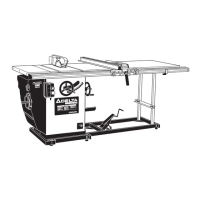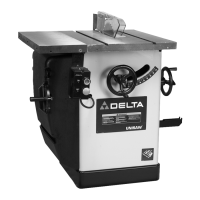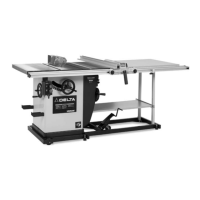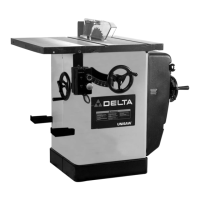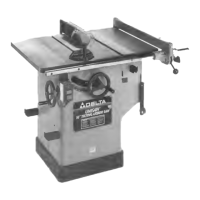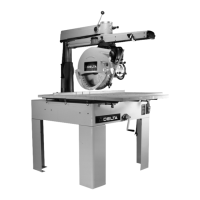5
TERMINOLOGY
Terms: the following terms will be used throughout the manual and you should become familiar with them.
•Through-cut refers to any cut that completely cuts through the workpiece.
•Non through-cut refers to any cut that does not completely cut through the workpiece.
•Push stick refers to a wooden or plastic stick, usually homemade, that is used to push small workpiece through the saw and keeps
the operator’s hands clear of the blade.
•Kickback occurs when the saw blade binds in the cut and violently thrusts the workpiece back toward the operator.
•Freehand refers to cutting without the use of a miter gauge or rip fence or any other means of guiding or holding the workpiece
other than the operator’s hand.
Never perform freehand cutting.
•Plunge cutting refers to blind cuts in the workpiece made by either raising the blade through the workpiece or lowering the
workpiece down to the blade.
Never perform plunge cutting.
•Resawing - Flipping material to make a cut the saw is not capable of making in one pass.
Resawing is not recommended.
•Cove cutting - Coving is an operation where the work is fed at an angle across the blade.
To reduce the risk of personal injury, do not perform cove cutting because table saw blades are not designed for
the excessive side loading needed.
SAW BLADE GUARD ASSEMBLY, ANTI-KICKBACK ASSEMBLY AND RIVING KNIFE
Your table saw is equipped with a blade guard assembly, anti-kickback assembly and riving knife that covers the blade and reduces
the possibility of accidental blade contact. The riving knife is a flat plate that fits into the cut made by the saw blade and effectively
fights kickback by lessening the tendency of the blade to bind in the cut. The blade guard assembly and anti-kickback assembly
can only be used when making through cuts that sever the wood. When making rabbets and other cuts that make non
through cuts, the blade guard assembly and anti-kickback assembly must be removed and riving knife lowered to the non
through cut position marked on the riving knife. Two anti-kickback pawls are located on the sides of the riving knife that allow the
wood to pass through the blade in the cutting direction but reduce the possibility of the material being thrown backwards toward the
operator.
Use all components of the guarding system (blade guard assembly, riving knife and anti-kickback assembly) for every operation for
which they can be used including all through cutting. If you elect not to use any of these components for a particular application
exercise additional caution regarding control of the workpiece, the use of push sticks, the position of your hands relative to the blade,
the use of safety glasses, the means to avoid kickback and all other warnings contained in this manual and on the saw itself. Replace
the guarding systems as soon as you return to through cutting operations. Keep the guard assembly in working order.
MAKING A PUSH STICK
In order to operate your table saw safely you must use a push stick whenever the size or shape of the workpiece would cause your
hands to be within 6" (152 mm) of the saw blade or other cutter. A push stick is included with this saw.
No special wood is needed to make additional push-sticks as long as it’s sturdy and long enough. A length of 15.7" (400 mm) is
recommended with a notch that fits against the edge of the workpiece to prevent slipping. It’s a good idea to have several push sticks
of the same length [15.7" (400 mm)] with different size notches for different workpiece thicknesses.
See the end of the English section for a picture of a push stick. The shape can vary to suit your own needs as long as it performs its
intended function of keeping your hands away from the blade.
KICKBACKS
Kickbacks can cause serious injury. A kickback occurs when a part of the workpiece binds between the saw blade and the rip fence,
or other fixed object, and rises from the table and is thrown toward the operator. Kickbacks can be avoided by attention to the
following conditions.
How to avoid them and protect yourself from possible injury
A. Be certain that the rip fence is parallel to the saw blade.
B. Do not rip by applying the feed force to the section of the workpiece that will become the cut-off (free) piece. Feed force when
ripping should always be applied between the saw blade and the fence; use a push stick for narrow work, 6" (152 mm) wide or
less.
C. Keep saw blade guard assembly, riving knife and anti-kickback assembly in place and operating properly. If anti-kickback
assembly is not operational, return your unit to the nearest authorized DELTA service center for repair. The riving knife must be in
alignment with the saw blade and the anti-kickback assembly must stop a kickback once it has started. Check their action before
ripping by pushing the wood under the anti-kickback assembly. The teeth must prevent the wood from being pulled toward the
front of the saw.
D. Plastic and composite (like hardboard) materials may be cut on your saw. However, since these are usually quite hard and
slippery, the anti-kickback pawls may not stop a kickback. Therefore, be especially attentive to following proper set up and cutting
procedures for ripping.
E. Use saw blade guard assembly, anti-kickback assembly and riving knife for every operation for which it can be used, including all
through-sawing.
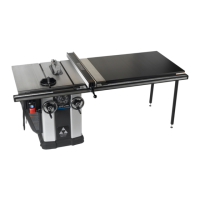
